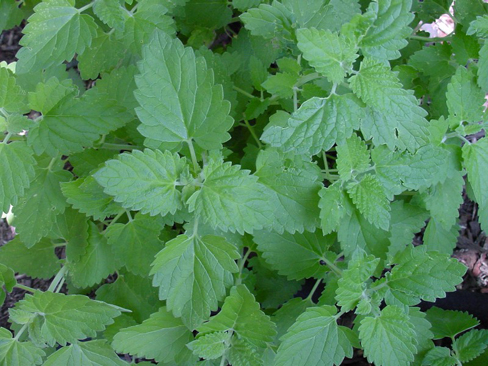Catnip
Catnip (Nepeta cataria), best known as a stimulant for cats, is a perennial herb in the mint family (Lamiaceae). Cats, both domestic and wild, are attracted to catnip mainly due to a compound known as nepatalactone present in plant tissues.
Marketing
Catnip is primarily marketed for cats in stuffed toys, catnip-filled balls, compressed pellets, and in shaker bottles. Marketing possibilities include farmers markets, pet stores, and higher-end retail stores. Growers should have an established market available before beginning production or limit their production to very small scale because many members of the mint family spread aggressively. Strong marketing skills are essential for success with a niche product like catnip. Most commercial catnip for toys is of a lower grade, consisting of dried, ground-up stalks, as well as leaves. However, the most aromatic portions of the plant are the blossoms and leaves. Savvy growers may be able to develop a market for a higher grade product, especially if well-packaged to retain freshness, and therefore, potency. Organic growers with an existing consumer base that prefers organic goods may also have a distinct marketing advantage.
Production
 Catnip is widely available as the botanical species (Nepeta cataria). Differences have been reported to exist in yield potential and chemical composition between commercially available seed lines.Catnip prefers sites with full sun, well-drained soil, and adequate moisture. This herb can be propagated by seed, stem cuttings, or division. Commercially grown catnip is generally seeded and grown in a greenhouse or hotbed until plants are the proper size for transplanting. Greenhouse float beds and transplanters designed for tobacco production could be used for catnip. Plants are then transplanted to the field mechanically or by hand once all danger of frost has passed. Small seed size, slow germination, and poor competitive ability with weeds makes direct seeding to the field difficult.
Catnip is widely available as the botanical species (Nepeta cataria). Differences have been reported to exist in yield potential and chemical composition between commercially available seed lines.Catnip prefers sites with full sun, well-drained soil, and adequate moisture. This herb can be propagated by seed, stem cuttings, or division. Commercially grown catnip is generally seeded and grown in a greenhouse or hotbed until plants are the proper size for transplanting. Greenhouse float beds and transplanters designed for tobacco production could be used for catnip. Plants are then transplanted to the field mechanically or by hand once all danger of frost has passed. Small seed size, slow germination, and poor competitive ability with weeds makes direct seeding to the field difficult.

